I left home at 5 AM on my Triumph Bonneville, arrived in Palafavera at about 9 AM, and left on foot half an hour later. I was eager to see the Civetta’s northwest face again, and it was as I remembered it: giant, looming, impressive, intimidating, outstanding. As I crossed the valley below, I thought about Marco Anghilleri, who completed the first winter repeat of the Solleder route on that wall, and just then, I came across a plaque, just below the summit’s vertical, announcing his passing on the Central Freney Pylon in 2014. He fell while attempting the first winter solo of a challenging route there.
Coldai Lake, immediately above the refuge and the homonymous saddle, at 2143 mt. On the left in the background is a glimpse of the huge west face of Civetta. The monumental northwest face of Civetta, more than 1,000 meters of vertical rock with a total extension of more than 4 km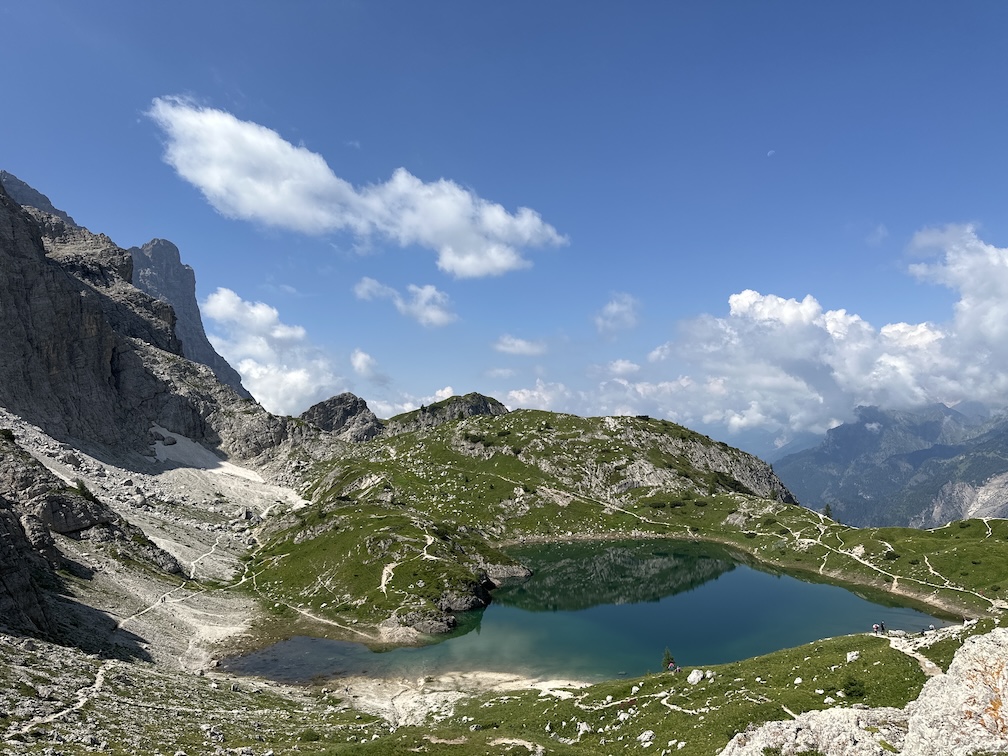
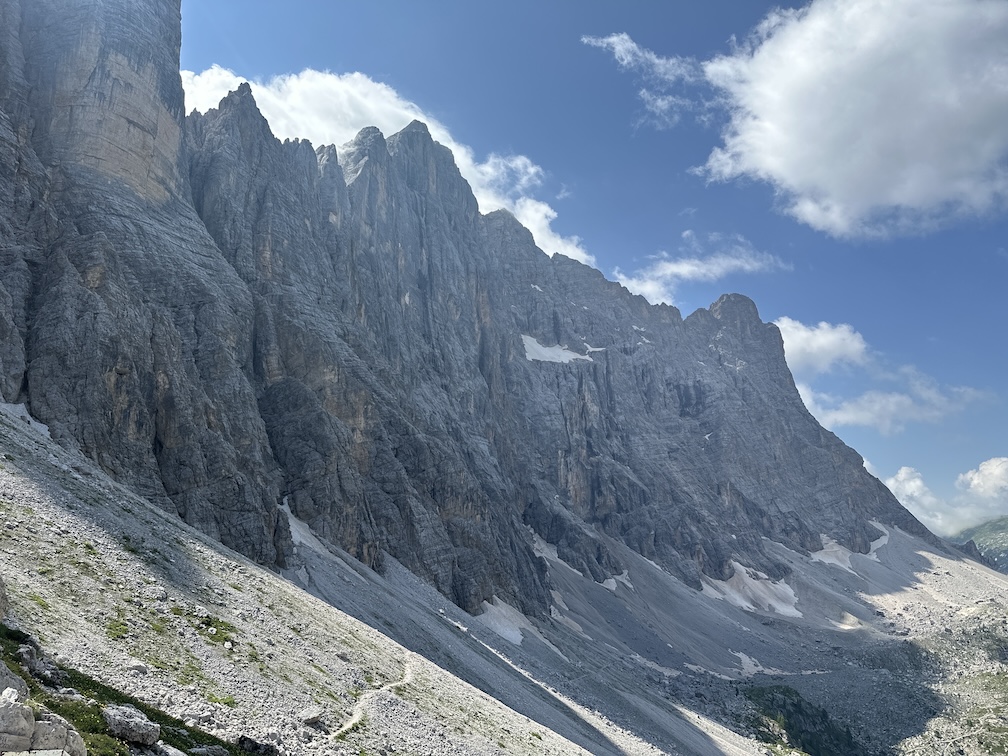
After the fork to the Rifugio Tissi, the crowd (literally) disappeared. We are on the Alta Via 1, which has become an international attraction since I walked it almost thirty years ago: French, Dutch, Americans, and Italians, all lining up to complete it, and I guess it is a good thing, or maybe not? I snacked on one of the two small sandwiches I had bought at a café in Zoldo, enjoying the sunshine in a surprisingly flat clearing that was undoubtedly once an alpine pasture. I was low on water but heard water running nearby as I ate. And indeed, there was a stream just a few meters from me, and I refilled my water bottle. This canteen has a water filter and costs a lot, but it grants safety and peace of mind. It is too bad it is small; I should have gotten the 1L version. 0.6L is small when you are out all day in the sun in summer, and there’s little to no water around.
Cason del Col Raen, a splendid and lonely alpine pasture, now abandoned.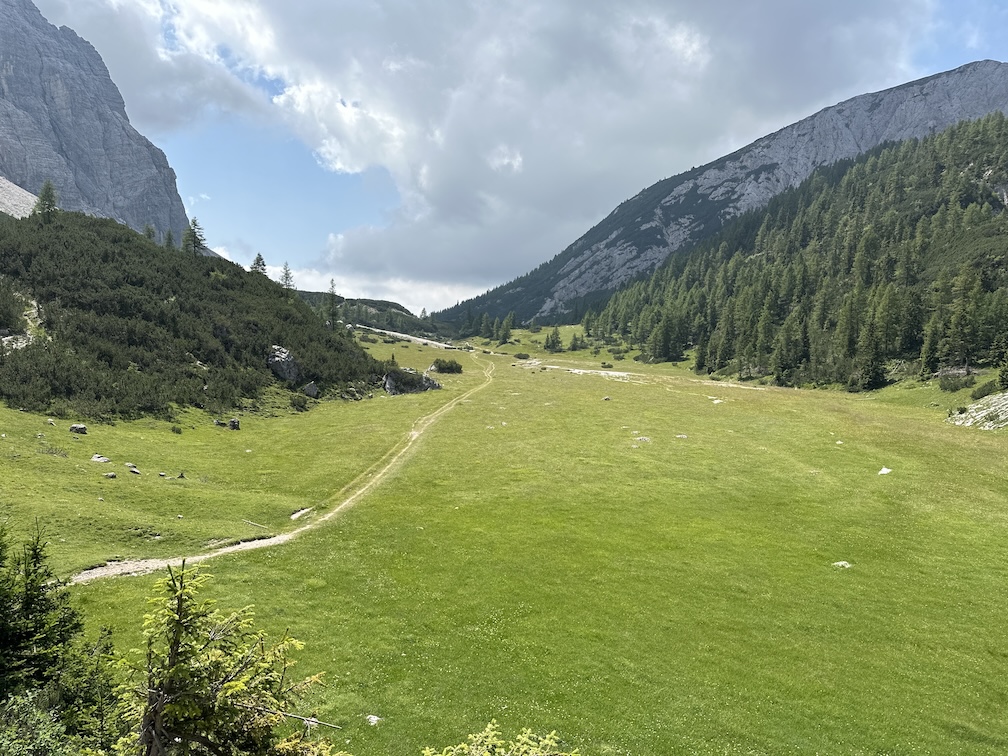
The evening at Rifugio Vazzoler was enjoyable. I had dinner at a table outside, sitting with five French people and one Spaniard. The French were two groups: three guys from Paris fleeing the 2024 Olympics and a couple from Lyon. She speaks Italian and breeds horses for a living, while he is an ultra-marathon runner who is a bit introverted and sulky but definitely on the ball. After the others went to bed, I chatted a little longer with Javier from Malaga. Last year, he did the Tour du Mont Blanc solo, his first real hiking experience. Remarkable. Like everyone else (except me) at the Vazzoler, he is now doing the Alta Via 1. After so much time avoiding them, I reevaluated the Alpine hut experience. In recent years, I have opted for wild camping away from the crowds. Still, the social aspect of sharing the experience in a cosy facility after a long day of strenuous hiking makes it all magical and unforgettable. There is another great advantage to the shelter: fewer logistical difficulties and less weight (tent, sleeping bag, stove, food) to carry around, which is no small thing, especially at 54. Looming over Vazzoler are Torre Venezia and Torre Trieste, the first of which I climbed almost thirty years ago. It was good to see it again and recall those strong emotions.
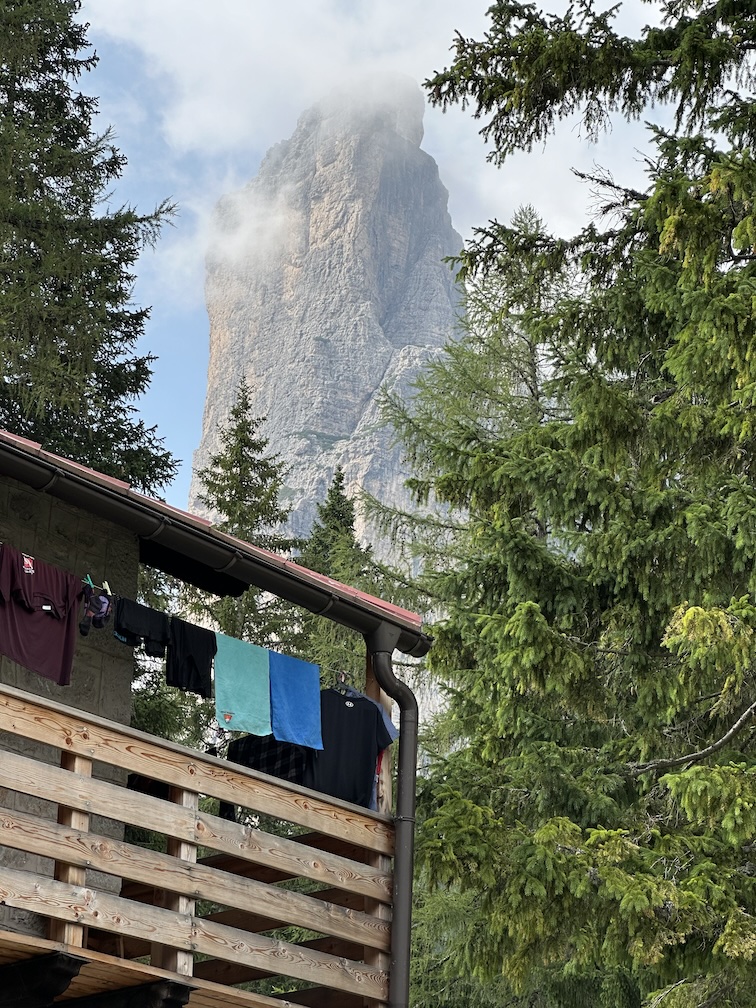
Torre Venezia as seen from Rifugio Vazzoler, where I spent the night.
After a restful night (I wouldn’t have guessed it, I was in a dormitory with 24 beds-luckily the one next to me was empty, and on the other side, I had the wooden wall-apt choice) I set off for the second and (much) more challenging stage, the one that would climb the very steep wall leading to Van delle Sasse and the fork above, then traverse the challenging Tivan Trail to Rifugio Coldai and then back to Palafavera. The climb was steady for almost 2 1/2 hours, always in an exciting environment. I never cease to be amazed at the wit of the hunters and hikers who, in ages long gone, have traced these daring routes. The Van delle Sasse is an isolated and wonderful high-altitude basin. There are no words to describe it. Almost unreachable, lonely, circled by a crown of peaks, with a flat, green plain just below the fork. It is the result of what used to be at the bottom of a massive glacier of lost epic. As I left early, I got up there first and met nobody the whole time. I rested and ate dried fruit at the Forcella delle Sasse above.
Torre Venezia (left) illuminated by the first light of dawn. I climbed the tower some 30 years ago. As always in mountaineering, the structure seen from afar is much more awe-inspiring than when you are in its arms. Forcella delle Sasse seen from Van delle Sasse below. The photo does not render the idea. At the foot of the fork, what appears to be a small green area is actually a plane at least the size of a soccer field, completely flat, green and perfect for camping at altitude. Van delle Sasse, seen from the Forcella delle Sasse. This is certainly one of the most remote and inaccessible places I have reached in my mountaineering experience.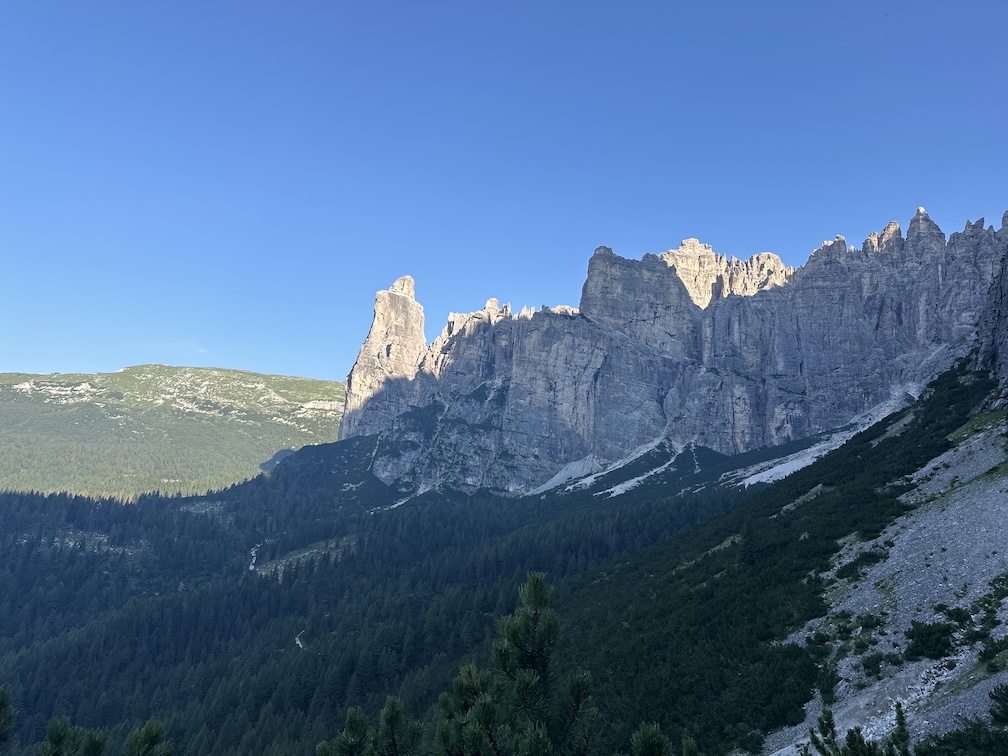

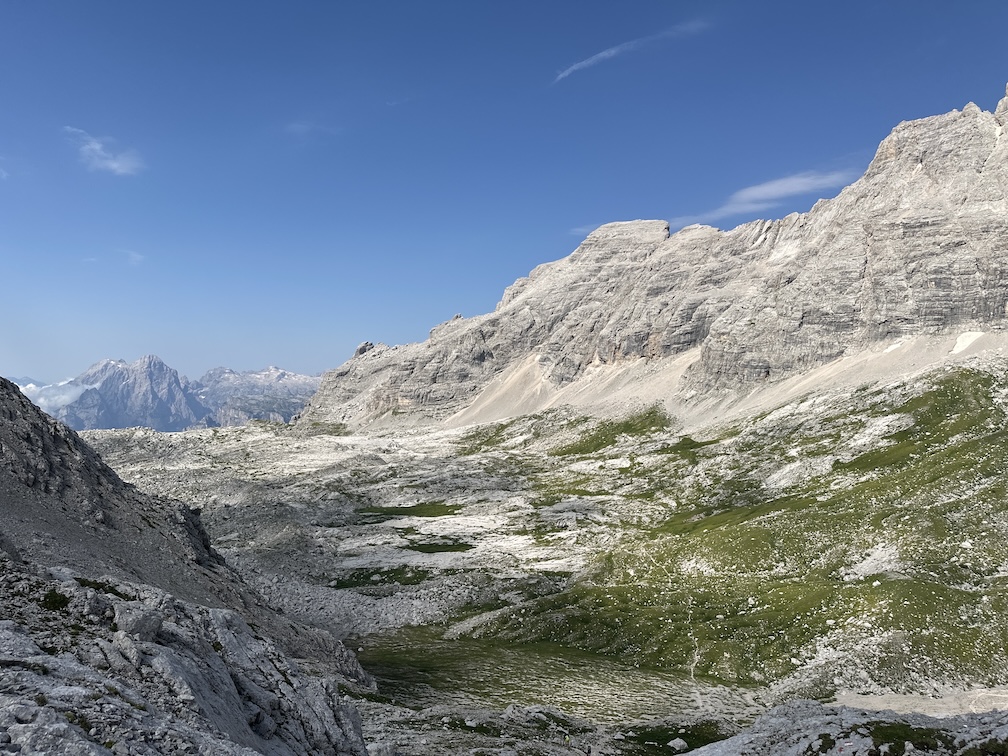
I began the rugged and steep descent, first on an equipped section (a few meters of iron cable), then on a very steep and slippery scree, and then I took the Tivan Trail to the left, which I must say I had underestimated. Very long, a continuous up and down at the foot of the looming Civetta walls. When it connects with the trail that goes up to Coldai from Pecol, it becomes a steady though not steep climb, interrupted often by exposed and equipped (again, iron cables) downhill sections, practically until the vicinity of the refuge. Tivan Trail is a wild, strenuous, exposed, lonely, precious experience. I was alone the whole time.
View looking east from Forcella delle Sasse, the highest point of the route at 2476 meters. Monte Pelmo as seen from the Tivan Trail. I climbed Pelmo solo about 25 years ago: it is still there.
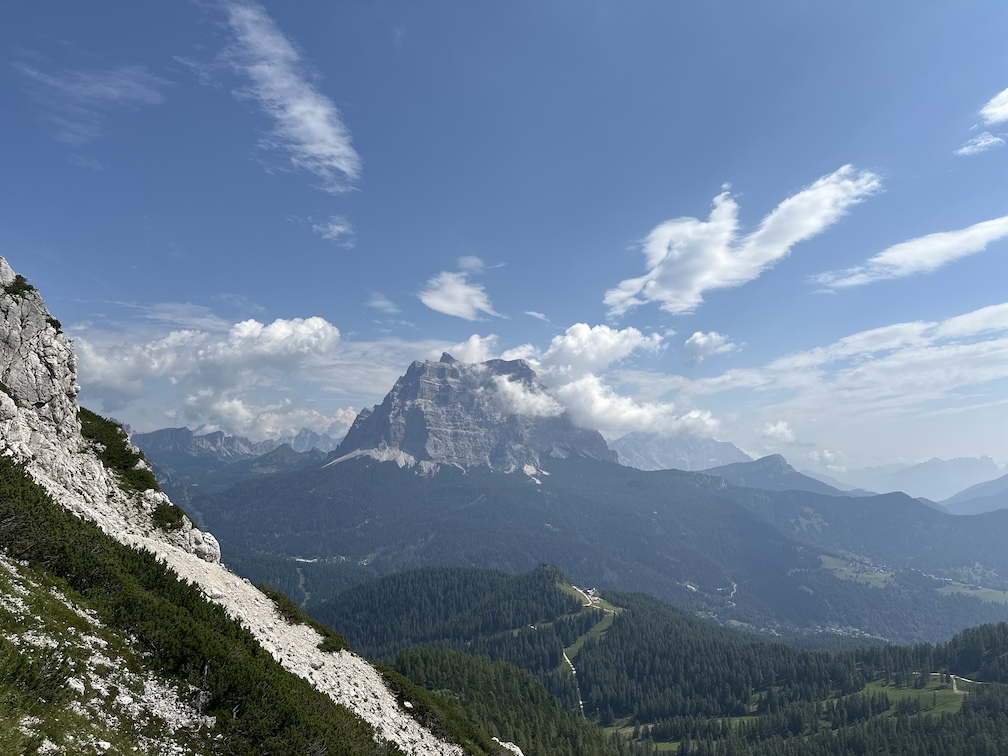
I arrived at the hut very tired. There, I ate the sandwich the Vazzoler guys had made me, drank a Radler (a mixture of beer and Lemon soda the Germans like to drink; it didn’t particularly quench my thirst), and walked down back for one more hour to the parking lot, where my trusty Bonneville was waiting for me.
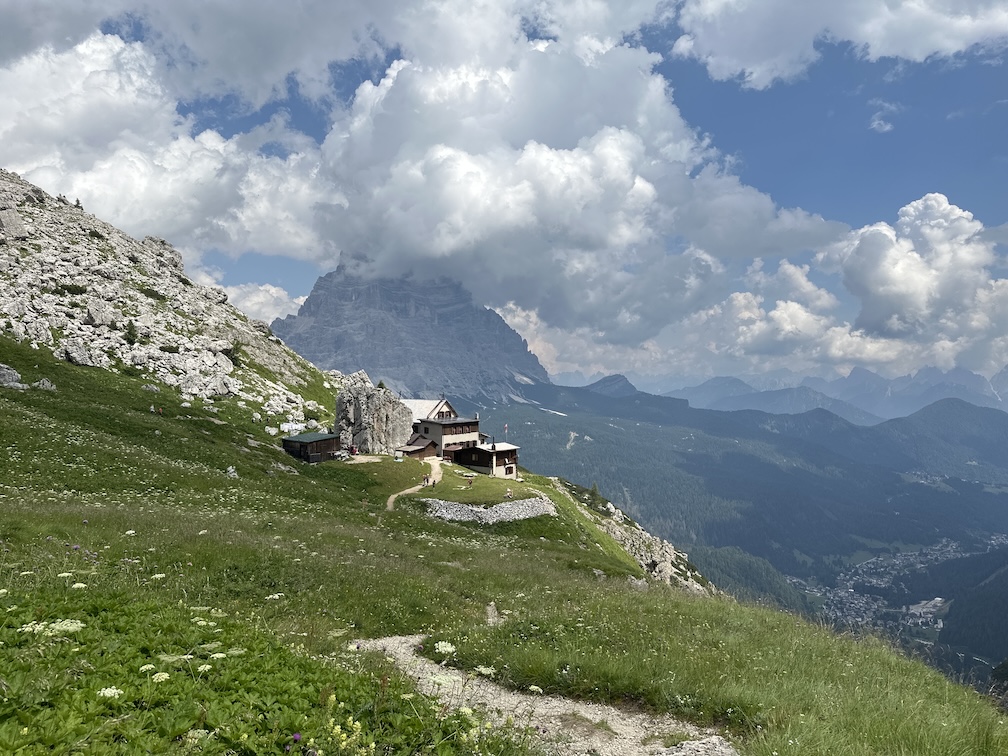
The much-coveted Rifugio Coldai, as seen on my return from the two-days Tour of Mount Civetta trail. From there, it’s only one more hour of descent till the parking, where my trusty Triumph Bonneville awaits.
It was a glorious day. Unfortunately, I sprained my ankle (my usual ankle) shortly after starting the climb to Van delle Sasse. I was sore but didn’t stop for a moment, and it slowly became manageable. Later, on a vertically equipped section on the descent, now 20 minutes, maybe less from the Coldai hut, I sprained the ankle again, which hurt a lot more this time. From experience, I was expecting this second accident to happen. I let out a terrible scream, I’m afraid, but I was alone, and no one could have helped me anyway. I slowly dragged myself to the hut, one step after another, hiking poles being crucial in this situation. Strangely enough, after lunch at Coldai, I could descend to Palafavera almost normally, with virtually no pain.
After the second sprain, I sat, looked at the view, and said, “OK, this is my goodbye to the mountains.” I can’t hurt my ankle that often: it’s a problem, a fragility that sooner or later could put me in serious trouble, especially since I go solo on wild trails like the Tivan. I was convinced. But at the same time, I started wondering what I could do about it. Have Dr Calderoni examine me, maybe talk to him about my problem and hear if/what can be done, even if only on the level of rehabilitation exercise (I’m very pessimistic: I’ve been exercising for years, ankles included). I’ve been thinking about the ankle braces that Jannik Sinner and other professional tennis players use. On my first day back from the trip, I ordered something similar on Amazon.
Today, I am less convinced about my goodbye to the mountain1.